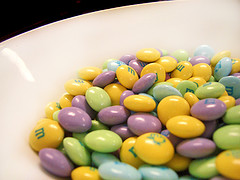 This weekend, children will be hunting for food colored eggs and candies full of artificial food dyes. Bright pink marshmallow bunnies, blue dyed eggs, multi-colored jelly beans…it’s an overload of these petroleum-based colorants.
This weekend, children will be hunting for food colored eggs and candies full of artificial food dyes. Bright pink marshmallow bunnies, blue dyed eggs, multi-colored jelly beans…it’s an overload of these petroleum-based colorants.
We first reported about the concerns of food additives being linked to hyperactivity in 2007 citing an even earlier study:
It is not only children with ADHD who are affected by additives, but all children’s behavior changes as a result of these substances. According to a 2004 WebMD report,
British researchers found removing food additives from the diet of a group of 3-year-olds caused a reduction in the children’s hyperactive behavior reported by their parents. And when the food colorings and preservatives were added back into the children’s diets, the parents reported an increase in hyperactivity.
Just a few weeks ago, the FDA met to examine this link between food dyes and hyperactivity in children. We are behind the Europeans on this one, NPR reports:
Despite concerns with the British study, European lawmakers now require a warning label on foods that contain artificial dyes. It lets parents know their kids might become hyperactive if they consume the product.
Manufacturers overseas, instead of adding a warning label, have turned to natural dyes made from beets and turmeric. Some U.S.-based manufacturers are considering switching to natural dyes, but as the food industry points out, natural dyes are more expensive and less stable.
It’s not just obnoxiously colored candy that is loaded with food dyes, but even childhood favorites like Mac and Cheese. Healthy Child Healthy World explains:
Do you have neon colors in your kitchen? In kitchens across the country, artificial food dyes can be found in everything from packaged macaroni and cheese to breakfast cereal to practically every piece of candy your child has ever put in her mouth. But, artificial food dyes have been linked to hyperactivity in kids (ADHD), cancer and serious food allergies, and GUESS WHAT? Due to enormous consumer pressure, large manufacturers like Kraft Foods voluntarily removed these artificial food dyes from products they sell in other countries, but not from the same products they sell in the US!
This Easter, be sure to avoid these dangerous food chemicals by:
1. Dye eggs naturally. Even though the food dye is only on the shell of the egg, we have all seen how it leaches through to the white of the hardboiled egg.
2. Fill your child’s Easter basket with natural candies ([amazon_link id=”B0023V64N6″ target=”_blank” container=”” container_class=”” ]Yummy Earth[/amazon_link], [amazon_link id=”B002TN3WK6″ target=”_blank” container=”” container_class=”” ]Endangered Species[/amazon_link], etc.) or fruit
3. Fill the basket with natural [amazon_link id=”B0019D2BFE” target=”_blank” container=”” container_class=”” ]raffia[/amazon_link] grass to avoid cross contamination from that brightly colored plastic stuff.
4. Exchange any artificial food dyed candy your child may receive from well-meaning friends and family for the good stuff.
5. Make healthy muffins or cookies instead candy.
With these five simple tips, you can avoid food dyes during this spring holiday and beyond.
Image: ![]() Some rights reserved by Incase.
Some rights reserved by Incase.
Trader Joe’s sells candy made with natural colors and flavors too. I bought some to swap out with the crappy candy my kids will inevitably receive from well-meaning friends and family. Love the idea of baked goods instead!